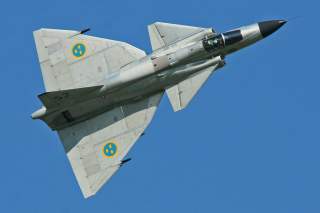Cold War Showdown: The Swedish JA-37 Viggen vs The SR-71 Blackbird
What happened?
As told by Crickmore, the first successful intercept of an SR-71 over the Baltic was carried out by Per-Olof Eldh, who recalls the incident: “In the 1980, I joined the 2nd Squadron “Blue Marlins” of Fighter Wing 13, equipped with the JA-37 fighter Viggen and based at Bravalla, just outside the town of Norrkšping, on the Baltic coast. Our mission was to conduct operational task and evaluation focused on air defence and air superiority. We were already equipped with a datalink from the air defence network; the next step was to establish it between fighters and we achieved this in 1981. Integrating this with the PS-46 air-to-air pulse-Doppler radar and the Skyflash missile provided the JA-37 with a significant enhanced capability. Looking at the map display on the MFD, the pilot could see other friendlies, the enemy, SAM sites, etc, and this information was constantly updated via the datalink by fighter controllers and other JA-37s, giving the pilot unprecedented levels of situational awareness. In fact, the system was so good that we could employ the same tactics – line abreast, box formations or scissors maneuvers – day or night in VFR or IFR [visual flight rules or instrument flight rules] conditions.
When i conducted the first Swedish Air Force intercept of an SR-71, the target had completed its north-bound pass of the Soviet coastline, and had turned west, south of the Finnish island of Aland, and was tracking south of a heading that would take it between Gotland and Öland. The datalink from the fighter controller was on, and I lined up for a head-on attack with a target angle of 180°. From my altitude of 8.000m I accelerated to Mach 1.35 then pulled up, very gently, continuing to accelerate to between Mach 1.7 and Mach 2.0, topping out at between 18.500 and 20.000m. All the target data was on my map display, including radar detection of the target at maximum range, which then locked on immediately afterwards. I simulated missile launches – the closing velocity was very high, between Mach 4.5 and 5.0; the SR-71 was flying at Mach 2.98 and 21.500m.
I had visual contact.
In total I have five hot intercepts against the SR-71 to my credit. All can be described as successful. I was visual three times; on a couple of occasions the SR-71 was contrailing, which was very useful because you could do a visual check to ensure you ended up in the right spot!
When we began conducting these SR-71 intercepts, the squadron began a special air safety program and we all underwent an intense series of emergency procedure checks in the simulator, because we were flying at the outer edges of the envelope and at higher risk.
On January 1986, while leading a JA-37 three-ship in aircraft tail number “38”, we received target data immediately after take-off from Bravalla. We flew in trail, receiving updated target information over the link from both the fighter controller and the other fighters in the formation. All three of us carried out successful intercepts between 13:14 hours and 13:25 hours, about 50km west of the town of Visby, on the island of Gotland. Major Moller was number two, in tail number “60”, and Captain Ulf Johansson number three in tail number “53”.
I remember that the SR-71 was flying at an altitude of 22.000m and a speed of Mach 2.9. Ulf had some difficulties coming back to earth – he actually reached the target’s altitude and passed the SR-71 head-on at the same altitude with some side separation, but suffered a high temperature engine stall! A cartoon drawn by SAS Captain Stefan Lofren to commemorate this event was used as a poster in our briefing room.”
This article by Dario Leone originally appeared on The Aviation Geek Club in 2018.
Image: Wikimedia.

